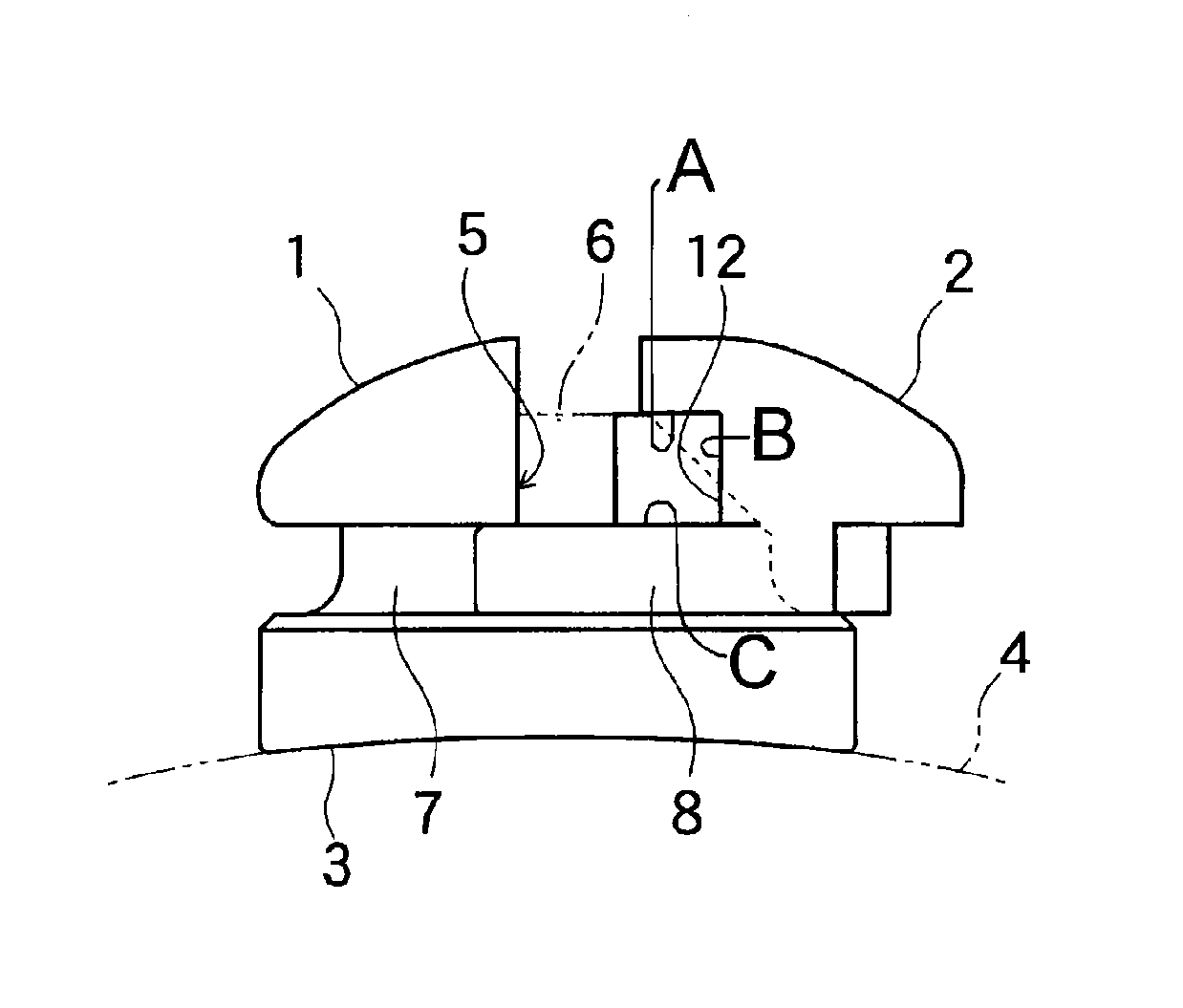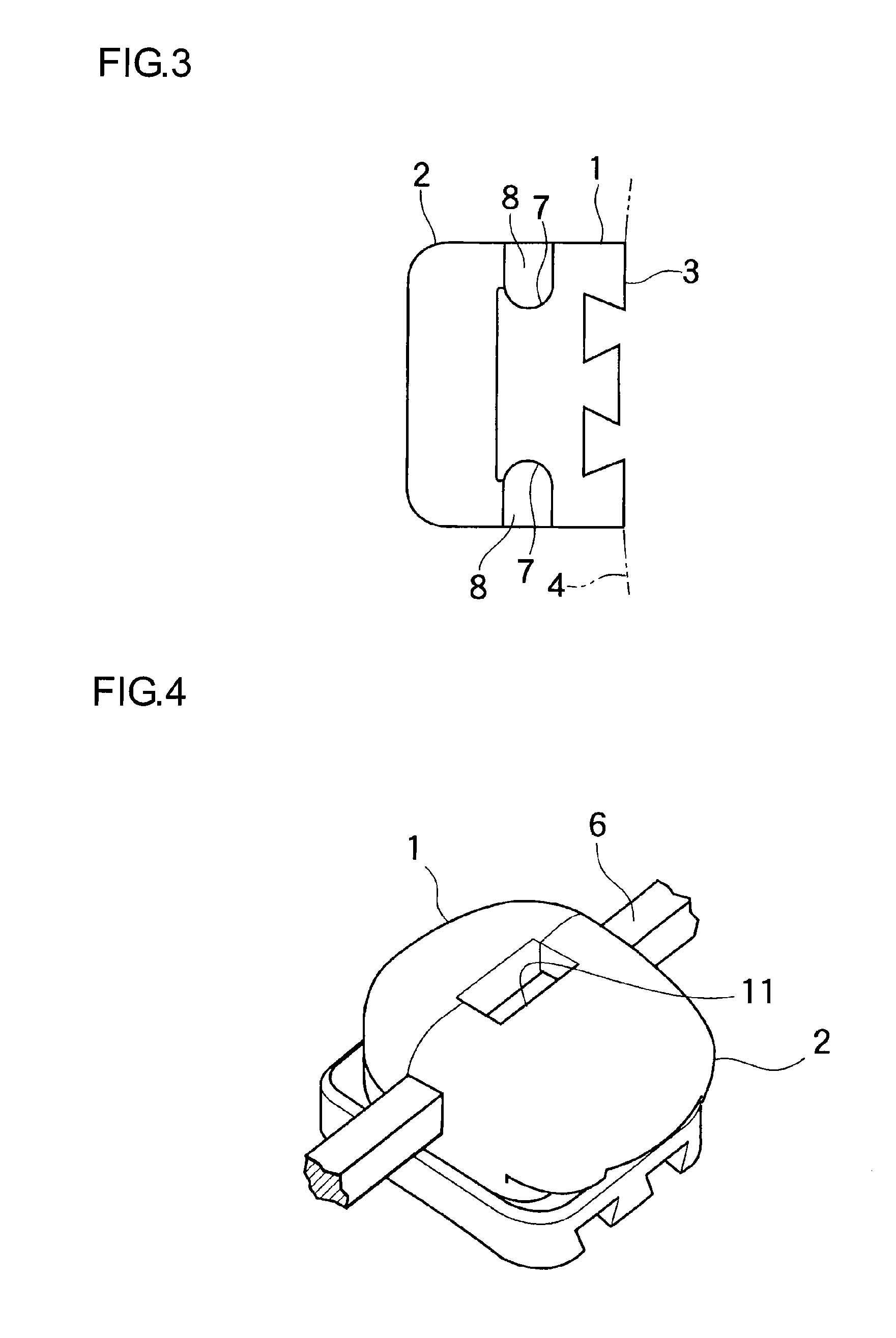Orthodontic bracket
a technology for orthodontic brackets and brackets, applied in the field of orthodontic brackets, can solve the problems of involute configuration, complex procedure for attaching and removing archwires, and inability to apply the pressor force over the necessary extent, so as to improve aesthetic appearance, less likelihood of residual food particles, and easy to carry out procedures for attaching and detaching
- Summary
- Abstract
- Description
- Claims
- Application Information
AI Technical Summary
Benefits of technology
Problems solved by technology
Method used
Image
Examples
first embodiment
[0094]FIG. 1 is a plan view of an orthodontic bracket according to a first embodiment of the present invention. FIG. 2 is a front view of the orthodontic bracket shown FIG. 1. FIG. 3 is a side view of the orthodontic bracket shown FIG. 1. FIG. 4 is an external view of the orthodontic bracket according to the first embodiment. FIG. 5 is a plan view of an orthodontic bracket showing a state in which a slider portion in the first embodiment is extracted. FIG. 6 is a front view of FIG. 5.
[0095]FIGS. 7 to 11 are drawings showing the configuration of the orthodontic bracket alone in the first embodiment. FIG. 7 is a plan view of the bracket body in the first embodiment. FIG. 8 is a front view of FIG. 7. FIG. 9 is a side view of FIG. 7. FIG. 10 is a cross-sectional view of FIG. 8 taken along line X-X. FIG. 11 is an external view of the bracket body alone in the first embodiment. FIG. 12 is a plan view of a slider portion in the first embodiment. FIG. 13 is a front view of FIG. 12. FIG. 14 ...
second embodiment
[0118]Explanation of a second embodiment will be made in accordance with FIGS. 21 and 22. FIG. 21 is a front view showing a second embodiment, which exemplifies an orthodontic bracket that is aligned with an anterior maxillary tooth. Although the shape of the face 20 for joining to a tooth and its surroundings in this embodiment differs from one in the embodiment mentioned above and the shape of the bracket body also differs, the configuration of the slider portion 2 is completely identical. While the configuration is not shown, it is the same for other teeth as well.
[0119]FIG. 22 shows an example in which elastic action of a wire is increased in the case of a thin archwire 21. While the above-mentioned slider portion 2 is composed to match standard slot dimensions, a gap is formed between the archwire 21 and the through groove 12 of the above-mentioned slider portion 2 in the case where the width dimension of the archwire 21 is small. There are cases in which an intended elastic ef...
third embodiment
[0122]Next, an explanation of a third embodiment will be made in accordance with FIGS. 23 to 29. This embodiment is an example of accommodating orthodontic treatment in the case of prominent crowding of teeth; In cases in which an archwire cannot be inserted into the slot in ordinary manners, unnecessary force ends up being excessively applied to the teeth when the archwire is forcibly inserted into the slot. In order to avoid this in such cases, the archwire of a bracket of a known wire ligating type is weakly ligated with a ligature wire with a portion of the archwire inserted into the slot and left in a suspended state. Further, in the case of a known self-ligating type of bracket in which the slot is covered, the cover portion can be left open by suspending a portion of the archwire from the slot. Moreover, since a ligature wire or rubber band cannot be used in the absence of wings, the configuration mentioned below is employed.
[0123]FIGS. 23 and 24 show an embodiment in which a...
PUM
 Login to View More
Login to View More Abstract
Description
Claims
Application Information
 Login to View More
Login to View More - R&D
- Intellectual Property
- Life Sciences
- Materials
- Tech Scout
- Unparalleled Data Quality
- Higher Quality Content
- 60% Fewer Hallucinations
Browse by: Latest US Patents, China's latest patents, Technical Efficacy Thesaurus, Application Domain, Technology Topic, Popular Technical Reports.
© 2025 PatSnap. All rights reserved.Legal|Privacy policy|Modern Slavery Act Transparency Statement|Sitemap|About US| Contact US: help@patsnap.com



